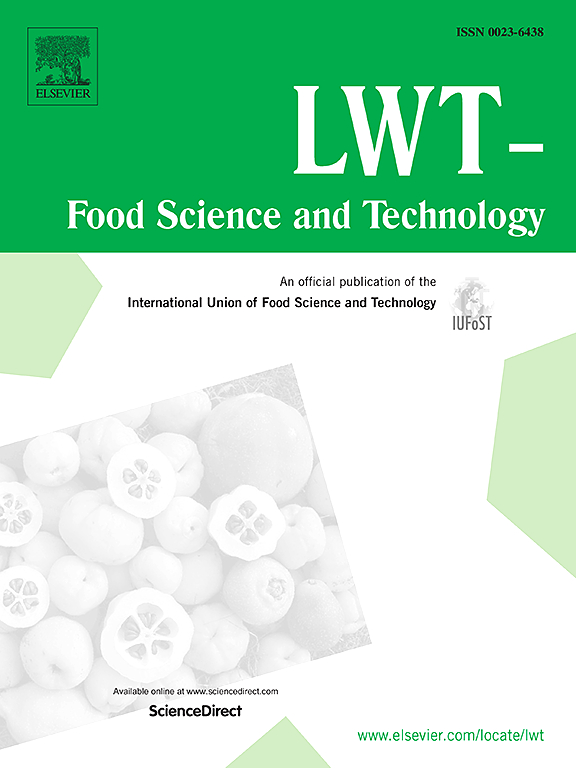Assessment of milling and the green biosolvents ethyl lactate and 2-methyltetrahydrofuran (2-methyloxolane) for the ultrasound-assisted extraction of carotenoids in common and phytoene-rich Dunaliella bardawil microalgae
IF 6
1区 农林科学
Q1 FOOD SCIENCE & TECHNOLOGY
引用次数: 0
Abstract
This study aimed to evaluate the efficiency of green solvents (ethyl lactate and 2-methyltetrahydrofuran (MeTHF)) compared to conventional solvents (ethanol, methanol, and dimethyl sulfoxide) in the ultrasound-assisted extraction of carotenoids from Dunaliella bardawil. Two types of algae were evaluated, a control (common) and a phytoene-enriched algae obtained by treatment with norfluorazon. The extractions were performed on fresh, freeze-dried, and encapsulated samples, with and without ball-milling pre-treatment. The pre-treatment had no significant effect on carotenoid extraction for any of the solvents tested. The solvents that achieved the highest carotenoid yield from fresh samples were MeTHF, methanol, and ethanol (control: 2105.3, 2001.8, and 1919.1 μg/g, respectively; phytoene-rich: 3220.9, 3669.1, and 3275.0 μg/g, respectively). In freeze-dried samples, ethanol was most effective in the control strain (14337.1 μg/g), while methanol yielded the most in the phytoene-rich strain (8464.1 μg/g). For encapsulated samples, MeTHF and ethanol were the top performers (control: 421.0 and 394.0 μg/g, respectively; phytoene-rich: 186.9 and 166.4 μg/g, respectively). Overall, the green solvent MeTHF proved to be a promising alternative to traditional solvents in the food industry.
评估研磨和绿色生物溶剂乳酸乙酯和 2-甲基四氢呋喃(2-甲基环氧乙烷)在超声辅助提取普通和富含植物烯的杜纳藻中类胡萝卜素的效果
本研究旨在评估绿色溶剂(乳酸乙酯和2-甲基四氢呋喃(MeTHF))与传统溶剂(乙醇、甲醇和二甲亚砜)相比在超声辅助提取杜纳藻类胡萝卜素中的效率。对两种藻类进行了评估,一种是对照组(普通藻类),另一种是通过使用诺氟沙星处理而获得的富含类胡萝卜素的藻类。对新鲜、冷冻干燥和封装样品进行了提取,并分别进行了球磨预处理和未进行球磨预处理。在所有测试溶剂中,预处理对类胡萝卜素的提取均无明显影响。从新鲜样品中获得类胡萝卜素产量最高的溶剂是 MeTHF、甲醇和乙醇(对照组:分别为 2105.3、2001.8 和 1919.1 μg/g;富含植物碱的样品:分别为 3220.9、3669.1 和 3275.0 μg/g)。在冻干样品中,乙醇对对照菌株最有效(14337.1 μg/g),而甲醇对富含植物油脂的菌株最有效(8464.1 μg/g)。在封装样品中,MeTHF 和乙醇的表现最好(对照:分别为 421.0 和 394.0 微克/克;富含植物油脂:分别为 186.9 和 166.4 微克/克)。总之,绿色溶剂 MeTHF 被证明是食品工业中一种很有前途的传统溶剂替代品。
本文章由计算机程序翻译,如有差异,请以英文原文为准。
求助全文
约1分钟内获得全文
求助全文
来源期刊

LWT - Food Science and Technology
工程技术-食品科技
CiteScore
11.80
自引率
6.70%
发文量
1724
审稿时长
65 days
期刊介绍:
LWT - Food Science and Technology is an international journal that publishes innovative papers in the fields of food chemistry, biochemistry, microbiology, technology and nutrition. The work described should be innovative either in the approach or in the methods used. The significance of the results either for the science community or for the food industry must also be specified. Contributions written in English are welcomed in the form of review articles, short reviews, research papers, and research notes. Papers featuring animal trials and cell cultures are outside the scope of the journal and will not be considered for publication.
 求助内容:
求助内容: 应助结果提醒方式:
应助结果提醒方式:


